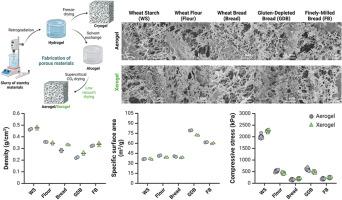Upcycling stale bread into (meso)porous materials: Xerogels and aerogels
IF 11
1区 农林科学
Q1 CHEMISTRY, APPLIED
引用次数: 0
Abstract
This work explores the upcycling of stale bread into bio-based, low-density porous materials with partial mesoporosity, produced through gelatinization and drying, using either supercritical CO2 (aerogels) or low-vacuum conditions (xerogels). Cryogels were also fabricated via freeze-drying for comparison purposes. Stale bread particles (Bread) were subjected to proteolytic gluten depletion (Gluten-Depleted Bread, GDB) or particle size reduction (Finely milled Bread, FB) to investigate the effect of protein removal or particle size on porous materials’ properties. Porous materials made from wheat starch (WS) and wheat flour (Flour) were also examined for comparison. The solvent exchange induced volume shrinkage (SE-VS), which accounted for over 87% of the total shrinkage, ranged from 62% in GDB to 78% in WS. Bread-based porous materials presented comparable specific surface area (∼40 m2/g) and water absorption capacity (∼400%) to WS materials, but outperformed in resistance to volume shrinkage, resulting in lower density. FB porous materials possessed a higher specific surface area than Bread materials, indicating the benefits of particle size reduction. Furthermore, gluten depletion resulted in GDB-aerogels with the highest specific surface area (∼80 m2/g), highlighting the benefits of gluten depletion. However, WS materials exhibited significantly greater maximum compressive stress (>2.0 MPa) and compressive modulus (>6 MPa) than stale bread-based porous materials. Importantly, the porous properties of xerogels and aerogels were similar (differences < 10%), indicating the feasibility of using low vacuum drying to produce new porous materials with partial mesoporosity (surface area 60–80 m2/g) from stale bread at a lower cost.

将过期面包改造成(中)多孔材料:疏水凝胶和气凝胶
这项研究探索了将过期面包转化为具有部分中孔率的生物基低密度多孔材料的循环利用方法,这种材料是利用超临界二氧化碳(气凝胶)或低真空条件(异凝胶),通过糊化和干燥制成的。为了进行比较,还通过冷冻干燥制造了冷凝胶。对陈面包颗粒(面包)进行蛋白水解麸质去除(麸质去除面包,GDB)或颗粒尺寸减小(细磨面包,FB),以研究蛋白质去除或颗粒尺寸对多孔材料特性的影响。此外,还对小麦淀粉(WS)和小麦粉(Flour)制成的多孔材料进行了比较研究。溶剂交换引起的体积收缩率(SE-VS)占总收缩率的 87% 以上,从 GDB 的 62% 到 WS 的 78% 不等。面包基多孔材料的比表面积(∼40 m2/g)和吸水能力(∼400%)与 WS 材料相当,但在抗体积收缩方面却优于 WS 材料,因此密度较低。FB 多孔材料比面包材料具有更高的比表面积,这表明了粒径减小的好处。此外,面筋耗竭导致 GDB 气凝胶具有最高的比表面积(∼80 m2/g),突出了面筋耗竭的益处。然而,WS 材料表现出的最大压缩应力(2.0 兆帕)和压缩模量(6 兆帕)明显高于基于陈面包的多孔材料。重要的是,异凝胶和气凝胶的多孔特性相似(差异为 10%),这表明利用低真空干燥以较低成本从陈面包中生产具有部分中孔率(表面积为 60-80 m2/g)的新型多孔材料是可行的。
本文章由计算机程序翻译,如有差异,请以英文原文为准。
求助全文
约1分钟内获得全文
求助全文
来源期刊

Food Hydrocolloids
工程技术-食品科技
CiteScore
19.90
自引率
14.00%
发文量
871
审稿时长
37 days
期刊介绍:
Food Hydrocolloids publishes original and innovative research focused on the characterization, functional properties, and applications of hydrocolloid materials used in food products. These hydrocolloids, defined as polysaccharides and proteins of commercial importance, are added to control aspects such as texture, stability, rheology, and sensory properties. The research's primary emphasis should be on the hydrocolloids themselves, with thorough descriptions of their source, nature, and physicochemical characteristics. Manuscripts are expected to clearly outline specific aims and objectives, include a fundamental discussion of research findings at the molecular level, and address the significance of the results. Studies on hydrocolloids in complex formulations should concentrate on their overall properties and mechanisms of action, while simple formulation development studies may not be considered for publication.
The main areas of interest are:
-Chemical and physicochemical characterisation
Thermal properties including glass transitions and conformational changes-
Rheological properties including viscosity, viscoelastic properties and gelation behaviour-
The influence on organoleptic properties-
Interfacial properties including stabilisation of dispersions, emulsions and foams-
Film forming properties with application to edible films and active packaging-
Encapsulation and controlled release of active compounds-
The influence on health including their role as dietary fibre-
Manipulation of hydrocolloid structure and functionality through chemical, biochemical and physical processes-
New hydrocolloids and hydrocolloid sources of commercial potential.
The Journal also publishes Review articles that provide an overview of the latest developments in topics of specific interest to researchers in this field of activity.
 求助内容:
求助内容: 应助结果提醒方式:
应助结果提醒方式:


